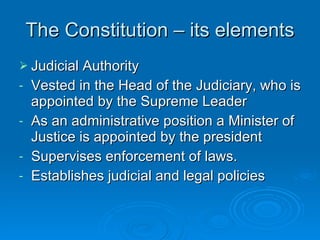Iraq 6
- 1. Comparative Politics Islamic Republic of Iran PoliSci Department SUNY @ Stony Brook POL 103 (Section 2) Spring 2005 Instructor: Udi Sommer
- 2. Geography - Borders East - Pakistan (909km of border) and Afghanistan (936km) Northeast - Turkmenistan (1000km) North - the Caspian Sea, Azerbaijan (500km) and Armenia (35km) West - Turkey (500km) and Iraq (1458km) South - Persian Gulf and the Gulf of Oman
- 3. Political history World War I British interests in the Middle East (oil) Iranian oil company is founded Reza Khan – a modernizing tyrant with nationalist tendencies (builds roads, railways, unversities, student exchange) Unpopularity at home, and suspicion he might join the Nazis abroad, lead to his fall
- 4. Political history Role during World War II Following WWII – heavy Soviet involvement in northern Iran. Marks the beginning of the Cold War Shah is replaced by his son under British influence Hopes that Iran would be a constitutional monarchy
- 5. Political history Politics quickly becomes unstable Mussadegh rises to power Initiates nationalization of oil industry CIA makes efforts to depose Mussadegh Under British and American influence the Shah forces Mussadegh from office. Profits of oil company are shared evenly with foreign nations
- 6. The White Revolution White as opposed to the Bolshevik revolution in Soviet Union which was red A revolution from above Shah wants to win progress economically and socially.
- 7. Elements of the Reform Importing western economic ideas Massive government financed heavy industries Land reform Women’s rights Investment in education
- 8. Problems No increase in democratic representation Corruption Not enough land to allow farmers to make their living Shiite clergy displeased with reduction of their influence in education Creates a major division in Iranian politics (reality in villages and reality in big cities)
- 9. 2 types of opposition to the Shah From the middle class – aspiring to establish a constitutional monarchy. Opposition from religious sects – despise reforms and the White Revolution, and perceive the Shah to be an American puppet.
- 10. Ayatollah Khomeini Leader of opposition to the Shah. Exile Turkey, Iraq, Paris Organizes a broader populist movement, using recorded speeches on cassettes, and through mosques. In 1978 it is the Islamic groups rather than the middle class that rally masses against the Shah.
- 11. Key elements of Iranian constitution Establish and facilitate people’s ability to live Muslim life Opposes monarchy Relations with non-Islamic groups Supervision by Islamic judges Representation of minorities Islamic Supreme Leader Foreign policy – independence from USA and the Soviet Union.
- 12. The Constitution – its elements Shiia Islam –official religion. The Supreme Leader: Head of state Elected and (potentially) deposed by Assembly of Experts Appoints the 6 religious members of the Council of Guardians. May dismiss president.
- 13. The Constitution – its elements The President: Universal suffrage 4 year terms Appoints and supervises Council of Ministers. Coordinates government Selects policies Council of Guardians screens candidates to the job.
- 14. The Constitution – its elements The parliament – the Majles Direct and secret ballot All its legislation is reviewed by the Council of Guardians No members of parliament are members of any of the councils or vice versa.
- 15. The Constitution – its elements The Guardian Council of the Constitution Authority to interpret constitution Constitutional review of laws Not a legislative body, but a power to veto. Composed of 6 Islamic clerics (selected by the Supreme Leader), and 6 memebers who are lawyers. Does not change with a change in Supreme Leader position
- 16. The Constitution – its elements The Assembly of Experts: Selects Supreme Leader Supervises the activities of the Supreme Leader Popularly elected Currently this is a conservative stronghold and thus considered a threat to the reform movement
- 17. The Constitution – its elements The Expediency Council Resolves legislative issues that Majles and Council of Guardians fail to agree upon Advises Supreme Leader on matters of national policy Oversees important policies Functions as a cabinet of Supreme Leader
- 18. The Constitution – its elements Judicial Authority Vested in the Head of the Judiciary, who is appointed by the Supreme Leader As an administrative position a Minister of Justice is appointed by the president Supervises enforcement of laws. Establishes judicial and legal policies
- 19. The constitution – institutional arrangement Supreme Leader Assembly of Experts Armed Forces Judic ial Authority Expediency Council Council of Guardians 6 Religious Members 6 Lawyers Majles (The Parliament) Council of Ministers President voters Key - supervise - advise - approval
- 20. Economy 3 components: State economy Cooperative economy Private economy Growth since revolution has slowed (due to revolution, war, oil price, management, inability to establish market economy)
- 21. Latest developments Reformers in the Majles and presidency Conservatives in the Council of Guardians and the Expediency Council Effects of War in Iraq, war in Afghanistan, and ‘Axis of Evil’ Relations with Turkey
- 22. Final comments The importance of the geographical location to the centrality of Iran in world affairs – consequential to domestic politics (e.g. relations with the USA). The level of democracy – some democratic features, defined as a non-democracy





















